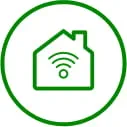In today's digital age, communication technology is evolving at a breakneck pace, with fiber internet standing at the forefront of this revolution. From crystal-clear voice calls to seamless video conferencing, fiber internet has transformed the very way we connect and interact. In this blog post, we’ll explore the innovations in voice and video communications that fiber internet has enabled and discover how this technology enhances our daily lives.
First, let’s talk fiber
Unlike traditional copper-based cable connections, fiber internet uses thin strands of glass or plastic to transmit data as light signals. This method allows for incredibly fast data transfer rates, leaving the capabilities of cable in the dust. When you pair that speed with greater reliability, increased security and low latency, fiber internet hasn’t just enhanced the entire digital experience for individuals and businesses alike but has paved the way for significant advancements in communication technologies.
Crystal-clear voice communications
High-definition voice calls: One of the most noticeable improvements brought about by fiber internet is the quality of voice calls. High-definition (HD) voice calls provide a much clearer and more natural sound compared to traditional phone lines. This clarity is achieved through higher bandwidth and better compression algorithms, made possible by fiber's high-speed data transmission. HD voice calls eliminate many of the typical distortions and background noises associated with conventional calls, making conversations more pleasant and reducing the need to repeat yourself (you know how annoying that is). This is particularly beneficial for businesses, where clear communication is crucial for productivity and collaboration.
VoIP and advanced telephony: Voice over Internet Protocol (VoIP) technology has been around for a while now, but its capabilities have been significantly enhanced with fiber internet. VoIP allows users to make voice calls over the internet rather than traditional phone lines, offering greater flexibility and reduced costs. With fiber internet, VoIP services can deliver superior call quality and reliability. Additionally, advanced features such as call forwarding, voicemail-to-email transcription and integration with other digital services are more effective and seamless. Once again, businesses, in particular, benefit from the scalability and versatility of VoIP systems, which can easily accommodate growth and changing communication needs.
Seamless video communications
High-definition video conferencing: Video conferencing has become an essential tool for both personal and professional communication. The advent of fiber internet has made high-definition (HD) and even 4K video conferencing a reality. These high-quality video calls are characterized by their sharp images, vibrant colors and smooth motion, providing a more immersive and engaging experience. For businesses, HD video conferencing facilitates more effective remote meetings, enabling clear visual communication and fostering better collaboration among geographically dispersed teams. In education, HD video enables interactive online classes, bringing students and teachers closer despite physical distances.
Low latency and real-time communication: Latency, which refers to the time it takes for data to travel from one point (like your computer) to another point (like a server hosting a website) and back is a critical factor in real time communications. The low latency of fiber internet ensures that video and voice signals are transmitted almost instantaneously, resulting in real-time communication that feels natural and uninterrupted. This low latency is especially important in applications like telemedicine, where timely interactions between patients and healthcare providers can be crucial. It also enhances the experience of live streaming, online gaming and other activities where real-time communication is of paramount importance.
Enhanced reliability and stability
One of the less obvious but equally important benefits of fiber internet is its reliability. Unlike traditional copper-based connections, fiber optics are less susceptible to interference from electrical equipment, environmental factors and even other kinds of cables. This results in a more stable connection, with fewer disruptions and outages. For voice and video communications, this means fewer dropped calls, less buffering during video streams and a more consistent overall experience. In critical situations, such as emergency response or important business negotiations, this reliability can make a significant difference.
The future of communication with fiber internet
With the adoption of fiber internet growing across the country, we can expect even more innovations in voice and video communications. Emerging technologies such as augmented reality (AR) and virtual reality (VR) are already benefiting from the high speeds and low latency of fiber, enabling new forms of interactive and immersive communication. In the not-too-distant future, VR meetings could become commonplace in the business world, providing a virtual presence that feels almost as real as being there in person. In education, AR is bringing interactive and engaging learning experiences to students around the world, breaking down geographical barriers and democratizing access to quality education.
Conclusion
Fiber internet has undeniably revolutionized voice and video communications, providing unprecedented speed and reliability, transforming both personal and professional interactions. With its high bandwidth and low latency, fiber-optic technology ensures crystal-clear voice calls and seamless video conferencing, eliminating the frustrations of lag and buffering. This advancement has enabled remote work, telemedicine, and virtual gatherings to flourish, fostering greater connectivity and collaboration across the globe. As fiber networks continue to expand, the future of communication looks brighter than ever, promising even more innovative ways to stay connected in our increasingly digital world.






